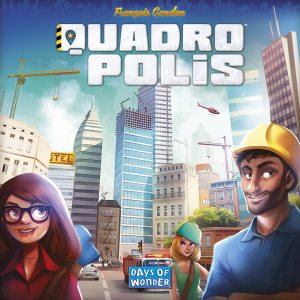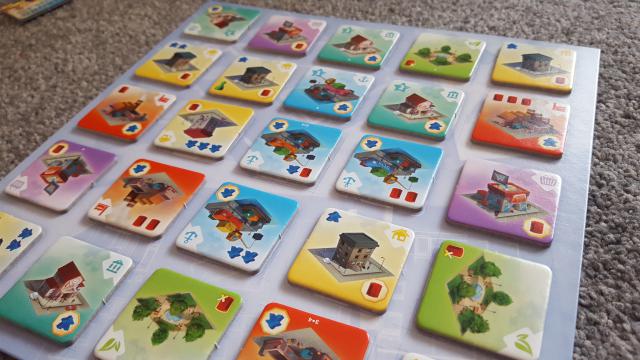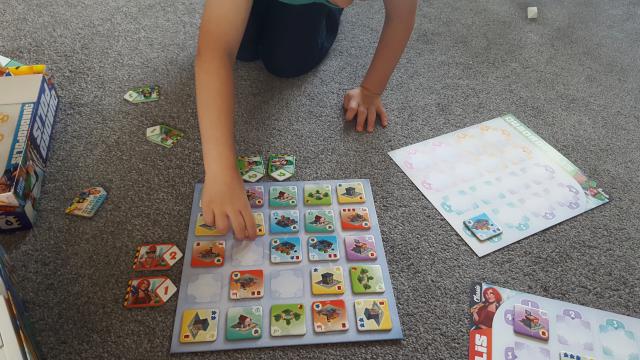
For a game with fairly simple rules there’s a surprising amount of depth to Quadropolis. On the surface it’s as simple as picking a building tile from the central board and placing it onto your own personal town, trying to marry up resources which you’ve earned with the buildings which need them. It feels almost like a solo game which you happen to be playing with other people, but once you start to spot some strategies to maximise your score and limit what other players can do things start to take a far more competitive turn. Add that to the fact that you’ve got two different difficulties of gameplay to try out and there’s far more to Quadropolis than initially meets the eye.
Once you’ve spent a sizeable chunk of time popping the tiles out of the boxed cards (there’s a fair few of them, I’d suggest doing this in advance if you’re planning to try it for the first time) the main board is filled randomly with the first set of building tiles; there are four main sets of building tiles, one for each round, and they’re divided nicely in the box to make it quick and easy to find each set. Each round is made up of 4 turns for each player, in theory giving them up to 16 tiles in total for their own board. It sounds like it should take a while with so many turns to take over the course of the game, but with players generally knowing what they’re trying to achieve things move at a pretty rapid pace, right up until the point that another player pulls a move which totally knackers your plans.

In each turn you place one of your four numbered architects on the edge of the main board, and take the tile which corresponds to that number – place the architect with a number 3 for example, and you take the tile three space in from that edge. You can then place that tile on your own smaller board in a row or column which, again, corresponds to the architect’s number. Simple enough. But you then move the black pawn on the main board to the space you’ve just freed up, blocking the next person from taking any tiles from that row or column. With everyone’s personal boards easy to see, it’s good fun and often a tactical move to block the next player along from taking certain buildings, and not unusual to take a building you don’t need just to prevent others from getting what they want.
But amongst all this it’s how you position the buildings and resources you earn on your own board that makes or breaks your game. Factories score points when positioned next to shops or harbours for example, and public service buildings will score you more points if you have them in several quadrants of your board. As such it’s worth thinking ahead, deciding on just what kind of game you’re going to try and play. Are you going to create a big score on harbours where a long line of them scores more points, or build some apartment blocks to maximise their point scoring by getting them to be 4 storeys high? Being able to tweak your strategy as the game presses on is pretty vital, but there are help cards to remind you which buildings do what and how they score, so you won’t need to remember each one individually.

The main game opens up though with the expert mode, which puts all of the architect cards into a pool which anyone can draw from, adds space for more buildings on each player’s boards and gives a far more tactical game – being able to pick from all of the architects which are left instead of your own four gives the game a totally different feel, and once you’ve experienced the more advanced way of playing you won’t want to go back, it just feels too restrictive.
So Quadropolis is an interesting mix of easy to play, slightly tougher to learn in terms of how best to put buildings together, and very challenging when you’ve got a group of players who know how to play properly. But I like games like that, easy to play but difficult to master. You’ll be able to get new gamers into this quite easily, hooking them in with the nice artwork and straightforward playing rules, but they’ll stay for more when things start to make more sense with the scoring and tactical options which open up as you work out what’s going on. It can feel a little bit like a solo game at times especially if everyone has a different tactic in mind, and it’s possible for a game to go by without much interaction between players, but on the whole it’s a very good game which we enjoyed playing, and definitely one which I’ll keep to hand for when a few people are over.
Quadropolis
Available Now, RRP £34.99
Find your local stockist here

Leave a Reply